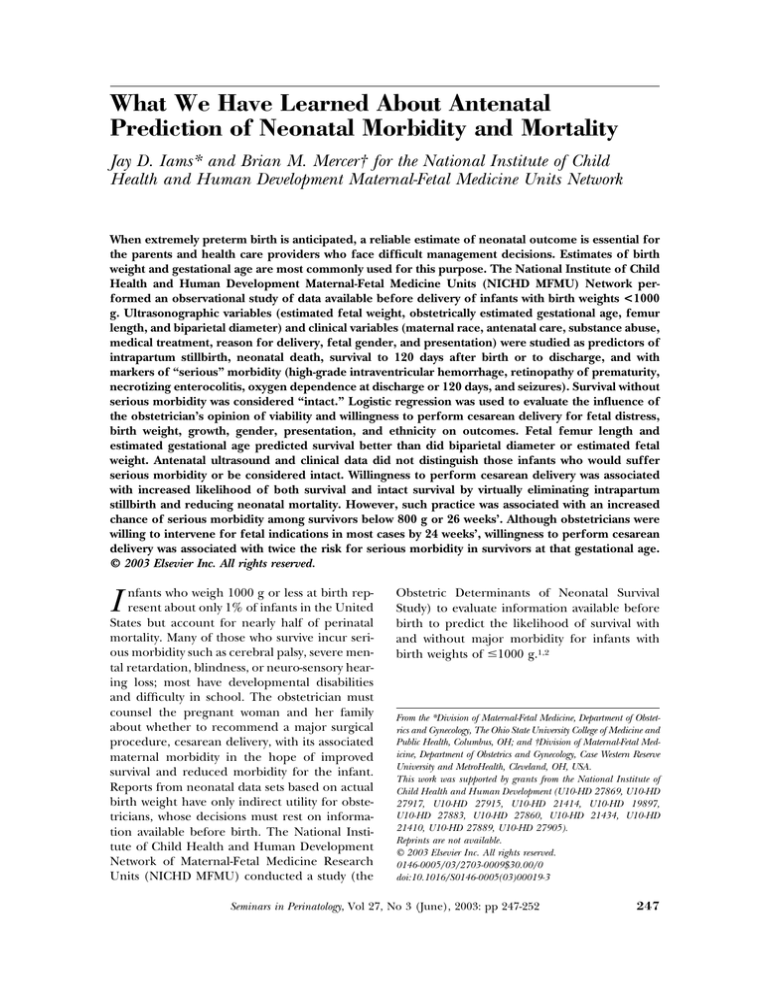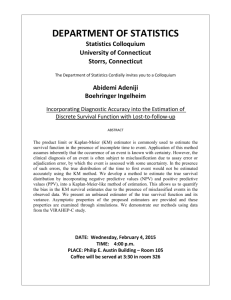
What We Have Learned About Antenatal
Prediction of Neonatal Morbidity and Mortality
Jay D. Iams* and Brian M. Mercer† for the National Institute of Child
Health and Human Development Maternal-Fetal Medicine Units Network
When extremely preterm birth is anticipated, a reliable estimate of neonatal outcome is essential for
the parents and health care providers who face difficult management decisions. Estimates of birth
weight and gestational age are most commonly used for this purpose. The National Institute of Child
Health and Human Development Maternal-Fetal Medicine Units (NICHD MFMU) Network performed an observational study of data available before delivery of infants with birth weights <1000
g. Ultrasonographic variables (estimated fetal weight, obstetrically estimated gestational age, femur
length, and biparietal diameter) and clinical variables (maternal race, antenatal care, substance abuse,
medical treatment, reason for delivery, fetal gender, and presentation) were studied as predictors of
intrapartum stillbirth, neonatal death, survival to 120 days after birth or to discharge, and with
markers of “serious” morbidity (high-grade intraventricular hemorrhage, retinopathy of prematurity,
necrotizing enterocolitis, oxygen dependence at discharge or 120 days, and seizures). Survival without
serious morbidity was considered “intact.” Logistic regression was used to evaluate the influence of
the obstetrician’s opinion of viability and willingness to perform cesarean delivery for fetal distress,
birth weight, growth, gender, presentation, and ethnicity on outcomes. Fetal femur length and
estimated gestational age predicted survival better than did biparietal diameter or estimated fetal
weight. Antenatal ultrasound and clinical data did not distinguish those infants who would suffer
serious morbidity or be considered intact. Willingness to perform cesarean delivery was associated
with increased likelihood of both survival and intact survival by virtually eliminating intrapartum
stillbirth and reducing neonatal mortality. However, such practice was associated with an increased
chance of serious morbidity among survivors below 800 g or 26 weeks’. Although obstetricians were
willing to intervene for fetal indications in most cases by 24 weeks’, willingness to perform cesarean
delivery was associated with twice the risk for serious morbidity in survivors at that gestational age.
© 2003 Elsevier Inc. All rights reserved.
nfants who weigh 1000 g or less at birth represent about only 1% of infants in the United
States but account for nearly half of perinatal
mortality. Many of those who survive incur serious morbidity such as cerebral palsy, severe mental retardation, blindness, or neuro-sensory hearing loss; most have developmental disabilities
and difficulty in school. The obstetrician must
counsel the pregnant woman and her family
about whether to recommend a major surgical
procedure, cesarean delivery, with its associated
maternal morbidity in the hope of improved
survival and reduced morbidity for the infant.
Reports from neonatal data sets based on actual
birth weight have only indirect utility for obstetricians, whose decisions must rest on information available before birth. The National Institute of Child Health and Human Development
Network of Maternal-Fetal Medicine Research
Units (NICHD MFMU) conducted a study (the
I
Obstetric Determinants of Neonatal Survival
Study) to evaluate information available before
birth to predict the likelihood of survival with
and without major morbidity for infants with
birth weights of ⱕ1000 g.1,2
From the *Division of Maternal-Fetal Medicine, Department of Obstetrics and Gynecology, The Ohio State University College of Medicine and
Public Health, Columbus, OH; and †Division of Maternal-Fetal Medicine, Department of Obstetrics and Gynecology, Case Western Reserve
University and MetroHealth, Cleveland, OH, USA.
This work was supported by grants from the National Institute of
Child Health and Human Development (U10-HD 27869, U10-HD
27917, U10-HD 27915, U10-HD 21414, U10-HD 19897,
U10-HD 27883, U10-HD 27860, U10-HD 21434, U10-HD
21410, U10-HD 27889, U10-HD 27905).
Reprints are not available.
© 2003 Elsevier Inc. All rights reserved.
0146-0005/03/2703-0009$30.00/0
doi:10.1016/S0146-0005(03)00019-3
Seminars in Perinatology, Vol 27, No 3 (June), 2003: pp 247-252
247
248
Iams and Mercer
Methods
All singleton infants with birth weights of ⱕ1000
g from November 1, 1992, to October 31, 1993,
at the 11 centers of the NICHD MFMU were
screened for entry. Extramural deliveries, antepartum stillbirths, infants born by induced abortion, and gestational age ⬍20 weeks were excluded from data collection. Information was
gathered from the medical record during the
week after delivery under protocols approved by
the institutional review board at each participating center. The hospitals represented in the
study are all academic referral centers with neonatal intensive care units. Data excluding patient
identification was transmitted weekly to the Biostatistics Center of the George Washington University for subsequent analysis. Data were collected during the week after delivery, recorded
in a standard format, and transmitted without
patient identification to the Biostatistics Center
of George Washington University, Washington,
DC, for subsequent analysis. Obstetric and neonatal information was limited to items customarily obtained in the course of clinical care. The
gestational age recorded was based on the “best
obstetric estimate” as defined at each institution.
The best obstetric estimate combined menstrual
history, early examination, and laboratory data
with the results of ultrasonographic examinations during pregnancy. Results of ultrasonographic examinations were available to the obstetrician before delivery in 97% of the cases;
51% had an ultrasonographic examination
within 3 days of delivery. Growth was classified
according to Brenner’s criteria for small and
appropriate for gestational age; there were no
large for gestational age infants.
The principal end points were intrapartum
stillbirth, neonatal survival to 120 days after birth
or to discharge from the hospital, and the presence or absence of indicators of serious morbidity at 120 days after birth or at discharge from
the hospital. The indicators of serious morbidity
were grade III or IV intraventricular hemorrhage, grade III or IV retinopathy of prematurity, necrotizing enterocolitis that necessitated
surgery, oxygen dependence at discharge or 120
days after birth, and seizures. Survival without
serious morbidity was considered “intact” survival, with the recognition that important but
less serious morbidity could occur among these
infants. The obstetrician’s opinion of viability
(yes or no) and willingness to perform cesarean
delivery (yes or no) in the event of fetal distress
were assessed from the medical record (79% of
cases), interview (9% of cases), or both (12% of
cases). A statement in the medical record documenting a discussion with the patient about
whether to perform a cesarean delivery for fetal
indications was present in 91% of cases. When
the statement was unclear (12%) or not present
(9%), study personnel interviewed the obstetrician about this question within 72 hours of the
delivery. The definition of fetal distress for study
purposes was the definition used in clinical practice at each participating center and included
fetal heart rate, periodic and nonperiodic patterns of change, beat-to-beat variability, and
scalp pH determination when appropriate.
To identify information available before delivery that most predicted neonatal survival for
extremely low birth weight infants, maternal age
and race (black v nonblack), prenatal care,
smoking, drug use, preterm ruptured membranes, preeclampsia, chorioamnionitis, time in
labor unit (⬍2 hours v ⱖ2 hours), corticosteroids, antibiotics, treatment with magnesium sulfate for any reason, use of any tocolytic medication and specifically of -sympathomimetic
agents, and fetal gender and presentation (vertex v nonvertex) were evaluated as categorical
variables. Fetal femur length, biparietal diameter, and estimated fetal weight were evaluated as
continuous variables.
Statistical analysis was performed with use of
SAS release 6.08 (SAS Institute, Cary, NC). Logistic regression was used to develop a model for
expected survival and to evaluate the influence
of the approach to obstetrical management, with
P ⬍ .05 considered significant. The pattern of
these results was further described with use of
50-g intervals of birth weight and 1-week intervals of gestational age.
Results
The charts of 1990 mother-infant pairs were
screened for enrollment. The reasons for ineligibility were fetal death before labor (n ⫽ 276),
birth before 20 weeks’ gestation (n ⫽ 271), multiple gestation (n ⫽ 237), and induced abortion
(n ⫽ 214). Eight hundred and eight singleton
infants met the study criteria (birth weight
Antenatal Prediction of Neonatal Morbidity and Mortality
⬍1000 g, gestational age ⱖ20 weeks’, alive at
admission to the hospital, and born after obstetric or medical complications, not as the result of
an induced abortion) and were enrolled. Of
these 808 infants, 63 were excluded because of
incomplete data and 32 were excluded because
of malformations, leaving 713 for analysis, 386 of
whom had known outcome and morbidity status
and an ultrasonographic examination performed within 3 days of delivery that recorded
femur length, biparietal diameter, and estimated fetal weight.
The population was 52% African American,
35% white, 10% Hispanic, and 2% Asian. The
mean maternal age was 25 years; 11% of mothers
were ⬍18 years and 10% were ⱖ35 years. Eightyfour percent of the mothers received prenatal
care. Thirty percent of mothers smoked tobacco
and 9% reported use of illicit drugs. Forty-two
percent of mothers had a menstrual calendar or
other method of verified menstrual dates within
a few days; 58% had unreliable menstrual dates.
Thirty-six percent had the date of first fetal heart
activity according to Doppler ultrasonography
documented in their charts.
Obstetrical diagnoses antecedent to extreme
low birth weight delivery are shown in Figure 1.
The majority followed spontaneous preterm
birth [preterm labor (PTL) and preterm premature ruptured membranes (PPROM)].
Fetal and neonatal outcomes by obstetrical
gestational age for all infants are shown in Table
1. Stillbirth increased progressively with decreasing gestational age before 26 weeks’. From 26
weeks’ on, stillbirth was rare (0.7%), presumably
related to the obstetrician’s expectation of neonatal survival with a favorable outcome.
249
Influence of Obstetrical Expectations of
Survival on Management
To evaluate the relationship of obstetrical expectations and management on neonatal survival,
logistic regression models for survival and intact
survival with use of birth weight, growth (small
for gestational age or not), gender, presentation, and ethnicity were developed. The influence of the obstetrician’s expectations and willingness to perform cesarean delivery for fetal
benefit were evaluated by determining whether
adding these variables significantly improved the
logistic regression models for expected survival.
To further investigate the influence of the approach to obstetric management on neonatal
survival, we repeated the logistic regressions described above, adding mode of delivery. The
obstetrician’s belief of fetal viability was associated with improved chances of both survival (adjusted odds ratio 3.5, 95% confidence interval
2.1 to 5.9) and intact survival (adjusted odds
ratio 2.7, 95% confidence level 1.2 to 5.9) not
attributable to the other variables. Willingness to
perform a cesarean delivery at 24 weeks was
associated with survival (adjusted odds ratio 3.7,
95% confidence interval 2.3 to 6.0) but not significantly with intact survival (adjusted odd ratio
1.8, 95% confidence interval 1.0 to 3.3). The
differences in neonatal outcome at 24 weeks’
gestation according to the willingness to perform a
cesarean section for fetal indications are contrasted
in Figure 2 (obstetrician not willing to perform a
cesarean section) and Figure 3 (obstetrician willing to perform a cesarean section).
Willingness to perform cesarean delivery was
associated with an improvement in overall survival (intact plus serious morbidity), from 33%
(20 ⫹ 13) to 57% (40 ⫹ 17), but the chance of
having a survivor with serious morbidity doubled.
Prediction of Neonatal Morbidity and
Mortality
Figure 1. Obstetrical diagnoses antecedent to extremely low birth weight deliveries (Data from ref 2.).
Given the importance of the obstetrician’s expectations of survival on neonatal outcome, we
then analyzed the accuracy of several potential
predictors of outcome. This analysis was limited
to the 386 women who had an ultrasound examination of the fetus within three days of delivery.
Prediction of neonatal survival by categorical
250
Iams and Mercer
Table 1. Neonatal Outcome by Gestational Age
Outcome, N (%)
Survivor Outcomes (%)
Gestational
age (wk)
Total
Stillbirth
Neonatal
Death
Serious Morbidity
Intact
Survival
Serious
Morbidity
Intact
21
22
23
24
25
26
27
28
29
30⫹
Total
41
69
91
118
124
102
76
41
21
30
713
8 (19.5)
10 (14.5)
11 (12.1)
2 (16.9)
1 (0.8)
0
2 (2.6)
0
0
0
34 (4.8)
32 (78.0)
49 (71.0)
56 (61.5)
59 (50.0)
38 (30.6)
26 (25.5)
14 (18.4)
5 (12.2)
1 (4.8)
1 (3.3)
281 (39.4)
1 (2.4)
8 (11.6)
15 (16.5)
39 (33.1)
43 (34.7)
35 (34.3)
22 (28.9)
14 (34.1)
5 (23.8)
3 (10)
185 (25.9)
0
2 (2.9)
9 (9.9)
18 (15.3)
42 (33.9)
41 (40.2)
38 (50.)
22 (53.7)
15 (71.4)
26 (86.7)
213 (29.9)
100
80
62.5
68.4
50.6
46.1
36.7
38.9
25
10.3
46.5
0
20
37.5
31.6
49.4
53.9
63.3
61.1
75
89.7
53.5
clinical variables was assessed by 2 testing. Fetal
gender and presentation, maternal preeclampsia, and administration of steroids, magnesium
sulfate, and -sympathomimetic tocolytic agents
were significantly associated with survival (P ⬍
.05; Table 2). Race, prenatal care, smoking, illicit drug use, preterm ruptured membranes,
chorioamnionitis, time in the hospital before
delivery, -mimetic tocolysis, and antibiotic use
were not significantly related to survival in this
population.
Logistic regression analysis was used to model
survival according to estimated fetal weight from
ultrasonography, fetal biparietal diameter, fe-
mur length, estimated gestational age, and actual birth weight. Estimated gestational age and
femur length predicted survival equally well.
Both were superior to estimated fetal weight and
biparietal diameter but were not better than
actual birth weight according to receiver operator characteristic curve analysis. When ultrasonographic data and clinical variables were
combined in logistic regression models, the best
predictive model included femur length, biparietal diameter, gender, antepartum magnesium
sulfate administration, and black race (Table 3).
The combination of femur length and biparietal
diameter predicted survival better than did estimated fetal weight. Data that display the ultrasonographic measurements made within 3 days
of delivery and their relationship to outcome are
shown in Table 4.
Mean and threshold values for stillbirth, sur-
Figure 2. Neonatal outcome at 24 weeks of gestational age (obstetric estimate) when the obstetrician
was not willing to perform cesarean delivery for fetal
indications.
Figure 3. Neonatal outcome at 24 weeks of gestational age (obstetric estimate) when the obstetrician
was willing to perform cesarean delivery for fetal indications.
251
Antenatal Prediction of Neonatal Morbidity and Mortality
Table 2. Univariate Associations Between Individual Variables Studied and Increased Neonatal Survival of
Infants ⬍1000 g at Birth (n ⫽ 386)
Variable
Unadjusted
Odds ratio
95% Confidence
Interval
Rx steroids
Rx magnesium sulfate
Preeclampsia
Rx tocolytic agents
Vertex presentation
Female sex
No preterm premature rupture of membranes
Rx -sympathomimetic agents
No drug use
Black race
No chorioamnionitis
Rx prenatalcare
Cigarette smoker
Rx antibiotics
Hospitalized ⬎2 hr before delivery
3.34
2.98
2.86
2.47
1.98
1.79
1.39
1.36
1.25
1.22
1.16
1.11
1.10
1.01
1.05
2.03–5.51
1.89–4.72
1.57–5.24
1.62–3.78
1.32–2.99
1.20–2.69
0.93–2.08
0.80–2.32
0.61–2.55
0.82–1.83
0.76–1.79
0.64–1.92
0.71–1.71
0.67–1.51
0.63–1.74
vival with morbidity at 120 days after birth, and
intact survival are indicated. These data indicate
that ultrasonographic data cannot discriminate
intact from morbid survival but may be used to
determine a survival threshold, a value below
which no survivors or intact survivors are seen.
Conclusions
The principal contribution of this study is the
identification of a relationship between the obstetrical expectations of survival and willingness
to intervene in labor for fetal indications to neonatal outcome. Willingness to perform cesarean
delivery did not have a statistically significant
effect on the rate of intact survival for ELBW
infants. However, willingness to perform a cesarean for fetal indications eliminated intrapartum
Table 3. Optimal multiple logistic regression model
to predict neonatal survival of infants ⬍1000 g at
birth (n ⫽ 386)
Variable
Femur length
Biparietal
diameter
Female infant
Received
magnesium
sulfate
Black race
Adjusted
Odds Ratio
95%
Confidence
Interval
Statistical
Significance
9.10
3.92–21.10
P ⫽ .0001
5.40
3.06
2.76–10.55
1.71–5.45
P ⫽ .0001
P ⫽ .0002
2.69
2.42
1.48–4.87
1.38–4.25
P ⫽ .0011
P ⫽ .0021
Statistical
Significance
P
P
P
P
P
P
P
P
P
P
P
P
P
P
P
⬍
⬍
⬍
⬍
⫽
⫽
⫽
⫽
⫽
⫽
⫽
⫽
⫽
⫽
⫽
.001
.001
.001
.001
.001
.005
.109
.260
.542
.333
.488
.716
.667
.969
.852
stillbirth, increased intact survival slightly, from
13% to 17%, and doubled the number of survivors with markers for long-term serious morbidity. These findings underscore the consequent
Table 4. Mean and Threshold Values for
Ultrasonographic Biometric Measurements and
Estimation of Fetal Weight and Gestational Age,
Categorized by Outcome (n ⫽ 386)
Measurement
Biparietal diameter
(cm)
Mean*
Threshold†
Femur length (cm)
Mean*
Threshold†
Estimated fetal
weight (g)
Mean*
Threshold†
Estimated
gestational age
(wk)
Mean*
Threshold†
Stillbirth
Survival
and Neonatal With Serious Intact
Death
Morbidity Survival
5.6
—
6.1
5.0
6.4
5.2
4.0
—
4.5
3.7
4.7
3.8
583
—
23.1
—
759
382
25.1
21.3
843
496
25.9
22.6
NOTE. Estimation of fetal weight was by ultrasonography.
Estimation of gestational age was by best obstetric estimate,
including ultrasonographic data obtained within 3 days of
delivery.
*Mean, Mean value for each measurement or estimate for
infants in each column.
†Threshold, Value for each measurement or estimate below
which there were no survivors with serious morbidity or
intact survivors.
252
Iams and Mercer
importance of the second major finding of the
analysis: there are at present no antenatal markers that reliably distinguish extremely low birth
weight fetuses who will survive intact from those
destined for survival with serious morbidity. We
did identify ultrasound thresholds below which
survival and intact survival were unlikely. Parents
whose unborn fetus has a femur length below 37
mm and a biparietal diameter below 50 mm
should be advised against cesarean section for
fetal indications. It should however be noted
that these data were collected a decade ago in
1992-1993.
scholars in maternal fetal medicine. His fellows
uniformly praise him as a tireless champion on
behalf of protected time for fellows to be, well,
fellows –not just allowed but encouraged to
delve and learn at a pace and to a depth they
knew would never again be possible. We who
were privileged to watch his sparkling intellect,
curiosity, and persistence within the Network
Steering Committee could only wish that we had
been his fellows too. His legacy in our discipline
is huge, in the body of work he created and in
the careers and works of those he taught. He is
sorely missed.
Tribute to Sid Bottoms, Principal
Investigator: The Obstetrical
Determinants of Neonatal Survival Study
References
This study was conceived and directed by Dr.
Sid Bottoms of Wayne State University. Sid was
the Principal Investigator from Wayne State until his death during the interval between the
submission and publication of the first of the two
primary manuscripts that describe the results of
this study. Sid was a man of many diverse interests, principal among them the education of new
1. Bottoms SF, Paul RH, Iams JD, et al: Obstetric determinants of neonatal survival: Influence of willingness to
perform cesarean delivery on survival of extremely lowbirth-weight infants. National Institute of Child Health
and Human Development Network of Maternal-Fetal
Medicine Units. Am J Obstet Gynecol 176:960-966, 1997
2. Bottoms SF, Paul RH, Mercer BM, et al: Obstetric determinants of neonatal survival, antenatal predictors of neonatal survival and morbidity in extremely low birth weight
infants. National Institute of Child Health and Human
Development Network of Maternal-Fetal Medicine Units.
Am J Obstet Gynecol 180:665-669, 1999









